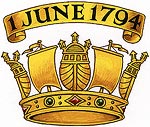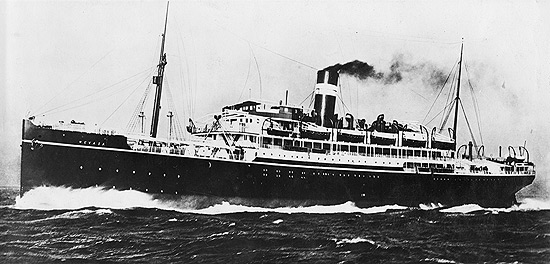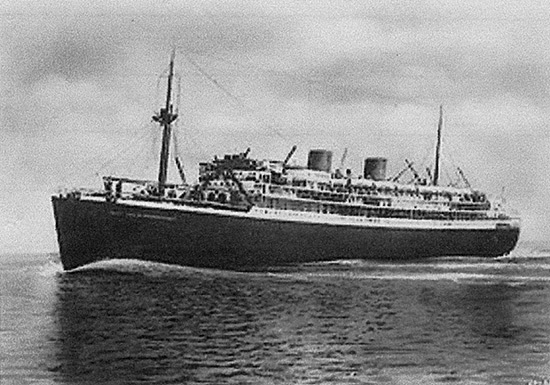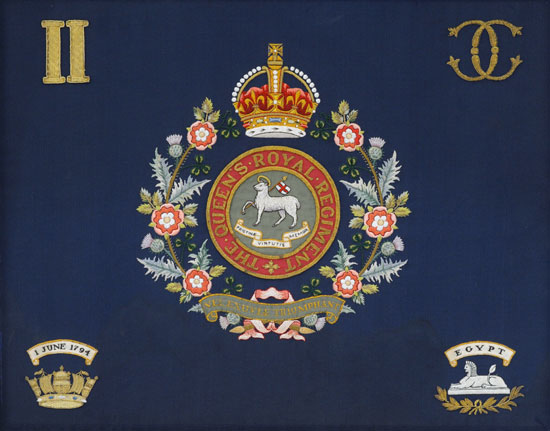Troopships and the Regiment
Some Voyages of The Queen’s Royal Regiment
The newly mustered Tangier Regiment sailed from the Downs on the 15th January 1662. The Earl of Peterborough sailed with his regiment in a fleet of some nineteen ships under the command of Admiral Sir John Minnes. Some of the ships in which the regiment travelled were the Royal James, Mary Montague, Ana, Princess, Yarmouth, Norwich, Colchester, The Nightengale, Merlyn and the Nonsuch.
 The fleet arrived at Tangiers on the 29th January 1662. The evacuation of Tangiers was concluded on the 3rd April 1684 when the Montague with Colonel Kirke (then commanding) arrived at Plymouth.
The fleet arrived at Tangiers on the 29th January 1662. The evacuation of Tangiers was concluded on the 3rd April 1684 when the Montague with Colonel Kirke (then commanding) arrived at Plymouth.
In 1793 the Regiment marched to Dover Castle to guard French prisoners of war. The Regiment was split up into detachments and served aboard ships of the fleet as marines. One detachment served aboard Admiral Earl Howes flagship, the Queen Charlotte. Other detachments were aboard the Royal George, Defence, Majestic and Russell, all took part in The Battle of the Glorious First of June.
On the 13th April 1927 the 1st Battalion embarked on HMT Nevasa bound for Hong Kong with stops at Port Said, Colombo and Singapore. The history records that the voyage was a happy one and the Nevasa was very comfortable.

HMT Nevasa
An interesting duty took place regularly whilst stationed at Hong Kong, the battalion supplied anti-pirate guards on various liners including the SS Empress of Canada as far as Shanghai.
In March 1929 the battalion left Hong Kong bound for Malta on board the HMT Somersetshire.
On Christmas Eve 1926 the 2nd Battalion left Bombay and disembarked at Port Sudan and completed their journey by train to Khartoum. They returned to England aboard the SS City of Marseilles, the same ship they had moved to Port Sudan on earlier.
Whilst stationed at Parkhurst, Isle of Wight the battalion were called upon to take part in the film OHMS, a propaganda film on board the new troopship HMT Dilwara. The 2nd battalion sailed for Palestine aboard HMT Nevasa on 1st January 1939.
The Second World War – The Queen’s Royal Regiment
Some details of voyages undertaken during the Second World War are recorded in the regimental histories. Three territorial battalions of The Queen’s, the 1/5th, 1/6th and 1/7th left their Dorset billets for Southampton. There they embarked, the 1/5th and 131 Bde HQ on the SS Duke of York, 1/6th in HMT Archangel and the 1/7th in SS Newhaven. They disembarked at Cherboug on the 2nd April 1940. The next mention is on the 7th June 1940 which records that the SS Vienna ‘embarked the whole brigade (35th) comprising 2/5th, 2/6th and 2/7th Queen’s at Cherboug and they then sailed for Southampton and arrived without incident.
After their successful campaign in the Western Desert and Syria the 2nd Battalion the Queen’s Royal Regiment embarked on the SS New Amsterdam and sailed east for what we now know as Srilanka and then to Burma, they became part of Wingates Chindit Force.
44 Division, with 181 Brigade, sailed at the end of May 1942 from Glasgow in a large convoy, with escort ships like HMS Rodney, HMS Nelson and an aircraft carrier and a number of destroyers. 1/6th and 1/7th Queen’s were in a British ship the HMT Strathallan (* picture with caption) and the 1/5th in an American ship the Christobal. The history records that ‘it took a while to get used to American food and cooking. Owing to the lack of space only two meals a day were served and these were eaten standing round the mess tables, but the food was excellent’.
The Johan van Oldenbarnevelt
The MS Johan van Oldenbarnevelt was built in Amsterdam at the Nederlandse Scheepsbouw Maatschappij, dockyard 194. The ship was launched on August 3, 1929 and construction was completed on March 13, 1930.

An early photo of the Johan van Oldenbarnevelt later the Lakonia.
In 1941 she was refited and was converted into a troopship at the Holland and Wolff shipyard. She was managed by the Orient Line and could carry a maximum of 4000 troops.
She was returned to her owners in February 1946 in her home port of Amsterdam.
In August 1942 169 (Queen’s) Brigade left England for service overseas. 2/5th Queen’s and 2/7th Queen’s were embarked in the Dutch liner Johan van Oldenbarnvelt, (19,429 tons). They sailed from the Clyde on 28th August and, after a call at Cape Town a month later, finally reached Bombay in safety on 16th September. The Regimental History records, ‘As a parting present to the Johan van Oldenbarnvelt and in recognition of the trouble all the ship’s company had taken for their welfare, the 2/5th and 2/7th arranged for Regimental crests to be worked in silk and presented to the ship on her next visit to England, where the master (Captain Broeur) was entertained at the Regimental Depot. They were hung in the first class lounge.’

The Regimental Plaque presented ot the Master, officer and crew of the MV Johann van Oldenbarnvelt by the 2/5th and 2/7th Battalions in appreciation of their safe arrival in Bombay, 1942.
For some time it was thought that the plaque had been lost when the Johann, after being sold to a Greek company and remaned the Lakonia, caught fire and sank in the Atlantic in 1966. However, Brigadier Allen Block, who commanded the 2/7th from 1941-43, heard from the Master, Captain Broere, that it was safe in Holland, and arranged for its return to Endland. It is now on display at the Regimental Museum. It is a fine example of the work of the Royal School of Needlework.
During the war she sailed though enemy infested waters without damage. She became known as the ‘Lucky Ship’. At the end of the war, still working as a troopship she departed Bombay where she had picked up 3668 troops, half being Allied POWs awaiting repatriation, including a number of the 2nd BN The East Surrey Regiment which had amalgamated with 2nd BN The Leicestershire Regiment to become The British Battalion. She arrived at Southampton on 29th October 1945 to a tumultuous welcome.
After the war, the ship was sold to Greek interests and became the ill-fated Lakonia, which was lost by fire in the Atlantic some years later. The Regimental crests had previously been removed by the Nederland Royal Mail Line. On the amalgamation of that line with other Dutch shipping companies in 1970, Captain Broeur was instrumental in the return of the plaque to the 2/7th Queen’s Old Comrades Association. The crests are now in the Regimental Museum at Clandon.
Travelling in the same convoy was the RMS Franconia with elements of Divisional Headquarters and the 2/6th Bn The Queen’s Royal Regiment. Sometime after the war, she ran aground on a reef in the St Lawrence river a mile from Quebec. She hit a submerged barrier a few minutes after leaving for Liverpool carrying 800 passengers. Eventually, she was replaced by a modern Franconia.
The history records that after arrival in Bombay the convoy was again divided the 2/7th Queen’s sailed from Bombay on the 25th October with the 9th Royal Fusiliers bound for Shat el Arab. The battalion disembarked at Margil.
Meanwhile, the 2/5th and 2/7th accompanied by 113 Field Regiment RA embarked on the HMT Rajula. They disembarked at Basra on the 13th November 1942.
